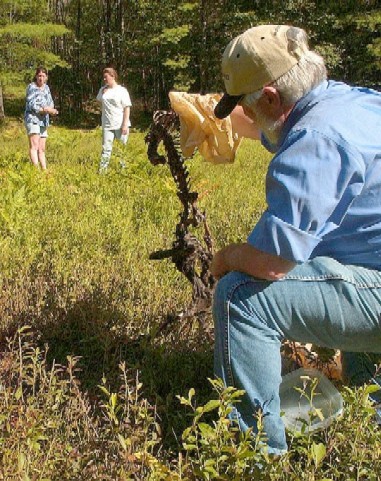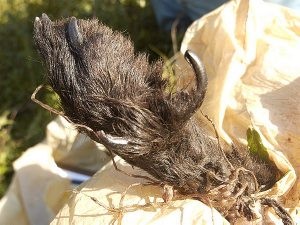
August 27, 2006
Your humble Cryptomundo cryptozoologist Loren Coleman examines the carcass of the beast or more correctly, what is left of it. In the background are, from left to right, Michelle O’Donnell and Debi Bodwell. This is a Sun Journal photograph by Douglas Van Reeth. Used by permission. Click to enlarge.
The August two weeks of the Maine Mutant’s silly season have passed. Surprisingly, the media aftermath has been mild.
I noticed on Friday, August 25, 2006, in California, John Boston’s (a/k/a Mr. Santa Clarita Valley) column in The Signal, “Where’s a Hairy MH When You Need One?”, attempted to be humorous, while coming off as illogically skeptical. (By the way, his “MH” is short for “Mutant Hybrid.”)
For example, I see Boston tried to have fun at my expense by noting:
Anyway, according to AP, a local cryptozoologist (like, how MANY cryptozoologists LIVE in Turner, Maine?) examined the corpse and, with a shiver, commented: “It’s unlikely the creature was anyone’s pet.”
Of course, what was left out was the rest of the quotation, which was that I mentioned a “feral dog.” Also, of course, I don’t live in Turner, but merely by coincidence call Portland, some 70 miles south, my home. It seemed an easy thing to do to go to Turner and examine the carcass, as opposed to the effort it has taken in the past to get to Loch Ness to interview witnesses, or travel to the Olympia rainforests to look at the evidence of Bigfoot encounters. But who said a columnist had to be complete or logical when trying to be funny?
Click on image for full-size version
Photograph by Michelle O’Donnell. Used by permission.
Meanwhile, back in Maine, a news item that merges into the realm of the unfortunate showed up this weekend in the Lewiston Sun Journal, where good articles by Mark LaFlamme have appeared.
“Mythical Monster: Turner Beast likely Wendigo, Says Canadian” was written by Judith Meyer, the managing editor for days at the paper. It was published on Sunday, August 27,2006.
On the one hand, Meyer is to be congratulated for assigning and supporting Mark LaFlamme’s work on the Turner beast, but on the other, this contribution by her shows the shaky tendencies of local journalism in the Internet age. It reflects editor Meyer’s apparent responsiveness to someone getting her ear, a little sloppy online research, and a tendency to be sensational or bow to popular culture in her examination of the “Turner beast.”
Meyer’s article seems to have been written before the DNA analysis came in on Friday, but that is no excuse for some of the mistakes one finds in the piece. First of all, she promotes the Wendigo as the creature found in Turner through a faulty expert. Wendigo, we are told, is the superhero villian in the Marvel comics, the title role of a 2002 fright flick, the horror focus of Algernon Blackwood’s book, and Stephen King’s principal monster of Pet Sematary. Okay, she can google “Wendigo.”
What, pray tell, has this to do with the animal found on the road in Turner, you ask?
Judith Meyer writes that the Wendigo:
…also may be, according to a Canadian researcher, the identity of the creature hit by a car in Turner on Aug. 12….Michael de Sackville…is immersed in cryptozoology, the study of unusual creatures. For de Sackville, the analysis is simple. Dogs have four toes only. Members of the weasel family, which includes the wolverine, have five. A photograph of the creature killed in Turner shows five distinct toenails, with the far left toe hidden from view. Two of the toenails are paired together on the animal’s dewclaw. Does that make six toes, or four toes with a deformed dewclaw on an otherwise ordinary dog? There are strong suggestions that the animal is a feral dog or some kind of wolf-dog hybrid. de Sackville acknowledges either is possible, “but it could also be a little monster long known to the Algonkian-speaking Aboriginal peoples of northeastern North America as the ‘wendigo.’…As far as the toe evidence, de Sackville describes mustelidae as having five toes, and not four like cats and dogs (and wolves). He asserts that a five-toenail Sun Journal photo “indicates that the ‘beast’ is probably not a ‘feral dog,’ but on the other hand it doesn’t look exactly like a modern wolverine either.”

The untrimmed dew claws of the animal killed by a car, and discovered alongside Route 4, Turner, Maine. Sun Journal photograph by Douglas Van Reeth. Used by permission.
Did Meyer or “Michael de Sackville” even pay any attention to the photos of this dead animal? Or examine its toes like I did or LaFlamme did?
My gosh, I’ve been in cryptozoology almost five decades, and the above noted “de Sackville” theory may be one of the silliest pieces of conjecture I’ve ever read when you have a dead dog right in front of you. First off, the Wendigo, Windigo, and other names are merely different monikers for the Eastern Bigfoot, a bipedal, hairy hominoid, not a four-legged creature, no matter how many toes you wish to talk about it having.
Please click on image for full-size version
Photograph by Michelle O’Donnell. Used by permission.
Meyer then appears to have done some more online research to find out what a Wendigo is. Sadly, she ends up quoting people who have talked about “the Inuit Indians in and around Minnesota” who have tales of the Wendigo or Windigo. Of course, the Inuit are not Indians, ethnically, culturally, or racially, and often incorrectly called Eskimos. The Inuit don’t live in Minnesota, of course, anymore than they live in Maine. Windigo are a part of the folklore of the Algonquian-speaking First Nations, Native Americans, and Native Canadians. There are plenty of Algonquian-related groups in Maine and Minnesota without wrongly bringing the Inuit into the picture.
I only wish Meyer would have done a little more research on her apparent initial source and contact, Michael de Sackville.
The question must be asked, who is “Michael de Sackville”? Meyer says “de Sackville, whose pen name is David Bradley, has written 23 nonfiction books on history and anthropology, including texts on the Holy Grail.” But did she fact-check this?
The reality is Michael de Sackville’s pen name is not “David Bradley.” The guy’s pen name is “Michael de Sackville” and his real name is Michael Bradley. His online presence is hardly cryptozoological. Indeed, at michaelbradley.com you will find this extraordinary entry:
Canadian Author of 23 books, 62, biography in Canadian Who’s Who as “Michael de Sackville”, serious but stable heart condition that could possibly be alleviated by future bypass operation, seeks female protographer and illustrator for two special book and film projects. By “photographer” I mean someone who is at least a “passable” semi-serious hobbyist at still photography (that is, a notch or two up from snapshots) and have her own fair-to-good quality digital or conventional cameras with several lenses.
* * *
I am tending toward someone of “Oriental” ethnic affiliation, mainly because I need to have a lot of brains and personality packed into an expremely petite package (about 110-115 pounds).
* * *
I am seeking someone younger than I am in order to supply some of the mobility and strength of relative youth, 25-45 years old, quite petite…
* * *
For those who have read Swords at Sunset, I should perhaps explain that my wife, Joelle Lauriol, helped me to post this advertisement, says that she is in favour of this plan and says she will assist with it. Joelle and I are presently reviewing our relationship and trying to re-define it. An immediate divorce is probably not in the cards, but a possible and eventual separation is extremely likely…in Canada or in France.
* * *
Joelle has suggested that our mutual strategy should include a “threesome” (or, in French, a “menage a trois”) for the duration of these projects, at least….
“Michael de Sackville” seems to be searching for something other than the Maine Beast or the Wendigo. Enough said. I just wish editor Judith Meyer had double-checked her so-called “cryptozoological” sources a bit more, and not fell into the blunders of her long article. Believe it or not, cryptozoologists do have standards to uphold and luckily people like “Michael de Sackville” are not members of our community. But then you won’t know that from reading Meyer’s article, sadly.
About Loren Coleman
Loren Coleman is one of the world’s leading cryptozoologists, some say “the” leading living cryptozoologist. Certainly, he is acknowledged as the current living American researcher and writer who has most popularized cryptozoology in the late 20th and early 21st centuries.
Starting his fieldwork and investigations in 1960, after traveling and trekking extensively in pursuit of cryptozoological mysteries, Coleman began writing to share his experiences in 1969. An honorary member of Ivan T. Sanderson’s Society for the Investigation of the Unexplained in the 1970s, Coleman has been bestowed with similar honorary memberships of the North Idaho College Cryptozoology Club in 1983, and in subsequent years, that of the British Columbia Scientific Cryptozoology Club, CryptoSafari International, and other international organizations. He was also a Life Member and Benefactor of the International Society of Cryptozoology (now-defunct).
Loren Coleman’s daily blog, as a member of the Cryptomundo Team, served as an ongoing avenue of communication for the ever-growing body of cryptozoo news from 2005 through 2013. He returned as an infrequent contributor beginning Halloween week of 2015.
Coleman is the founder in 2003, and current director of the International Cryptozoology Museum in Portland, Maine.
Filed under Breaking News, CryptoZoo News, Cryptozoology, Forensic Science, Media Appearances, Out of Place, Pop Culture, Public Forum, Swamp Monsters